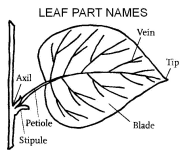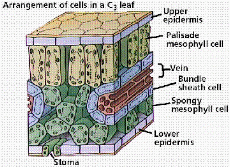Арсланова_Г_А_и_др_Essential_English_for_Biology_Students (1). Kazan federal university
 Скачать 7.01 Mb. Скачать 7.01 Mb.
|
UNIT VIII. STRUCTURE AND TRANSPORT IN PLANTSText 8.1 The Leaf■  Essential targets: By the end of this text you should be able to: describe the structure of a dicotyledonous leaf; distinguish between parenchyma, collenchyma, clerenchyma and sclerenchyma. Pre-reading ■ Working in pairs, discuss the following questions with your partner: 1. What does leaf shape provide? 2. How are leafs arranged on many plants? ■ Read the given text and make your essential assignments: The leaf is the main site of photosynthesis, the process by which green plants manufacture their own food. The lamina or blade of a leaf is flat and thin. Its shape provides a large surface area for absorption of light and carbon dioxide. The leaf is attached to a stem or branch by a leaf stalk or petiole. The stalk holds the leaf in a position such that its surface is exposed to the maximum amount of light. From the stalk, the main vein leads down the leaf with side veins branching out on either side. These veins connect the leaf to the rest of the plant, bringing the leaf some of the raw materials required for photosynthesis, and carrying products of photosynthesis away from it. This veins also provide mechanical support, maintaining the shape of the leaf. The stem and branches raise the leaves above the ground so they are exposed to the light. On many plants the leaves are arranged on branches in such a way that they do not shade one another. The tissues of a leaf In common with stems and roots, leaves are made up of three main types of tissue: epidermal tissue, vascular tissue, and ground tissue. Each tissue forms a continuous system throughout the plant. The epidermis covers and protects the leaves. It is the first line of defence against physical damage, infection, and being eaten. The upper epidermis consists of one or more layers of rectangular cells. In terrestrial plants, these epidermal cells secrete a waxy coating called the cuticle. The waxy cuticle is waterproof, minimising water loss from the surface of the leaf. It is often thicker on the upper surface, making this surface appear more shiny than the lower surface. The epidermis is perforated by microscopic pores called stomata. Stomata allow carbon dioxide and oxygen to gain easy access into the plant, but also allow water to escape. Each stomata is flanked by a pair of guard cells that regulate the size of the pore, closing it in times of water stress. Water is more likely to be lost from the upper surface of a leaf because it is more exposed to sunlight. The upper surface usually has fewer stomata than the lower surface; this minimises water loss. The vascular tissue consists of veins adapted to transpsort liquid substances around the plant, and it is made up of vascular bundles, groups of vessels running from the root up the stem and to the leaves. Xylem forms the upper part of a vascular bundle in the leaf, bringing water and mineral salts to the leaf. Phloem forms the lower part of a bundle, transporting sucrose and other products of photosynthesis away from the leaf. Ground tissue is all the tissue in a plant other than the epidermis, reproductive tissue, and vascular tissue. It makes the bulk of a leaf and consists mainly of parenchyma cells reinforced by collenchyma and sclerenchyma. The cells of the ground tissue Parenchyma cells are the least specialised of plant cells; they are characterised by having intercellular air spaces which vary in size. Parenchyma cells are regarded as the basic cells from which other cells have evolved. Parenchyma cells form the packing tissue of plants, and include the palisade cells and spongy mesophyll cells which make up the main photosynthesising tissue in the leaf. Palisade cells are a dense green colour due to the numerous chloroplasts they contain. These cells are packed tightly together in a regular arrangement near the upper surface of the leaf so they obtain the maximum exposure to light. The chloroplasts can move round inside the cells according to the amount of light available. If it is a dull day, they are often clustered at the tops of the cells, in the best position to trap light; in very sunny conditions, they may be grouped towards the bottoms of the cells to avoid being overexposed to light. T  he spongy mesophyll is the chief site of gaseous exchange in the leaf. It consists of rounded or sausage-shaped cells with fewer chloroplasts than palisade cells. The cells are closely arranged and between each of them are air spaces connecting the mesophyll with stomata. Collenchyma and sclerenchyma make up tissues that have a supportive, structural role in plants. In leaves, these cells are common around the vascular bundles (especially in midrib) and at the leaf tips. Collenchyma cells are elongated and have unevenly thickened cell walls with extra cellulose in the corners of the cells. There are two main types of sclerenchyma: fibres are very elongated and have very thick cell walls impregnated with lignin;sclereids (or stone cells) are more spherical in shape. Both types of sclerenchyma cells are specialised for support. Fibres in particular have great tensile strength and do not break easily when stretched. Mature sclerenchyma cells are dead because they are enclosed in a complete layer of lignin which is impermeable to water. ■ Glossary of essential terms for you to know
■ Your Essential Assignments I. Quick check 1. a) Which structure forms a waterproof layer on the surface of the leaf? b) Why is this structure thicker than the upper surface of the leaf than on the lower surface? 2. What is the main function of palisade cells? 3. How does collenchyma differ from sclerenchyma? II. Use monolingual English dictionary and write down what could the words given below mean: waterproof, shade, pore, infection, waxy coating, guard cells, root. III. Fill in the missing words:
IV. Find synonyms among the pool of words:
V. Give English equivalents to the following word combinations:
VI. Match these words with definitions:
VII. Give Russian equivalents to the following English terms:
VIII. Match the sentence halves. Make complete sentences.
IX. Answer the following questions. Use all information given before. 1. What does the leaf shape provide? 2. How are the leaves arranged on many plants? 3. What is the role of the waxy cuticle? 4. Is the ground tissue the same as the epidermis, reproductive tissue and vascular tissue? 5. How are palisade cells packed? 6. What makes chloroplasts move around inside the cells? 7. Why are mature sclerenchyma cells not alive? X. Read and translate the short text without any dictionary. Fact of life: The longest leaves belong to palm trees. Those of the palm Raphia ruffia (from which raffia fibres are obtained) may reach over 22 m long. XI. Food for thought Leaves from different species have an enormous variety of size, shape, and structure. In addition to being adapted to absorbing light for photosynthesis, to what other factors might leaves be adapted? XII. Translate into English using all the active possible. 1. Фотосинтез – это процесс, посредством которого, растения производят свою пищу. 2. Черешок удерживает лист в таком положении, чтобы поверхность листа получала максимальное количество света. 3. У многих растений листья на ветвях расположены таким образом, что они не затеняют друг друга. 4. Эпидермис представляет собой первую линию защиты листа от повреждений, инфекции и поедания животными. 5. Потеря воды с верхней поверхности листа более вероятна, т.к. она подвергается большему излучению солнца. 6. Сосудистая ткань состоит из жилок адаптированных к переносу жидких веществ ко всем частям растения. 7. Хлоропласты могут перемещаться внутри клеток в соответствии с количеством поступления света. 8. Пористый мезофилл – основное место газообмена в листьях. 9. Клетки располагаются свободно, и между каждой из них имеется воздушное пространство, соединяющее мезофилл с устьицем. 10. Колленхимные клетки являются удлиненными и стенки клеток имеют шероховатое утолщение и целлюлозу в уголках клеток. | |||||||||||||||||||||||||||||||||||||||||||||||||||||||||||||||||||||||||||||||||||||||||||||||||||||||||||||||||||||||||||||||||||||||||||||||||||||||||||||||||||||||||||||||||||||||||||||||||||||||||||||||||||||||||||||||||||||||||||||||||||||||||||||||||||||||||||||||||||||||||||||||||||||||||||||||||||||||||||||||||||||
